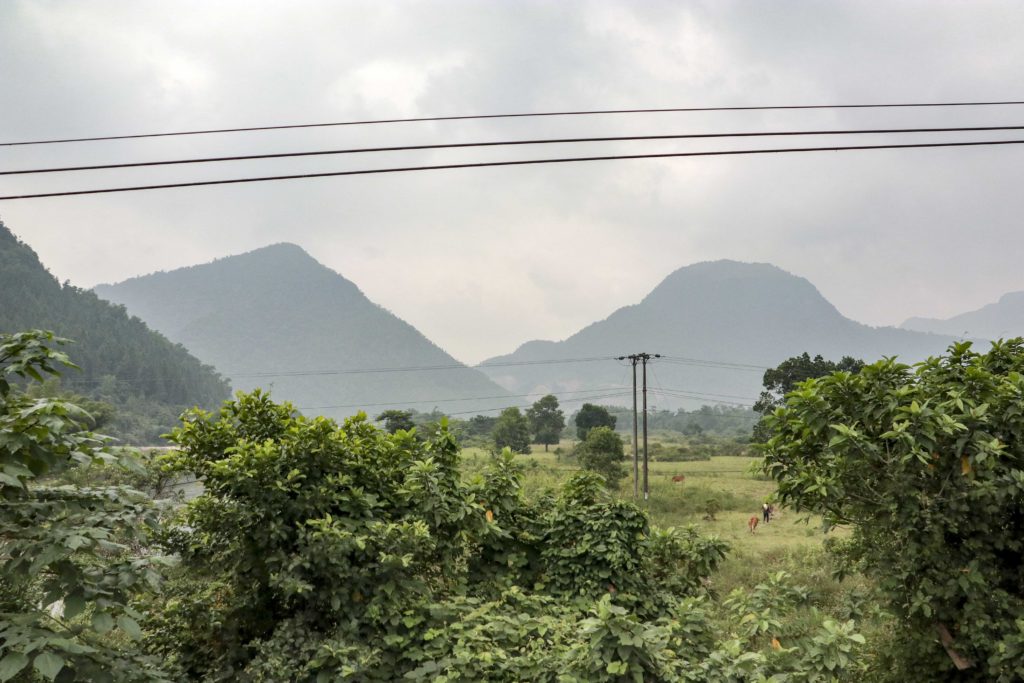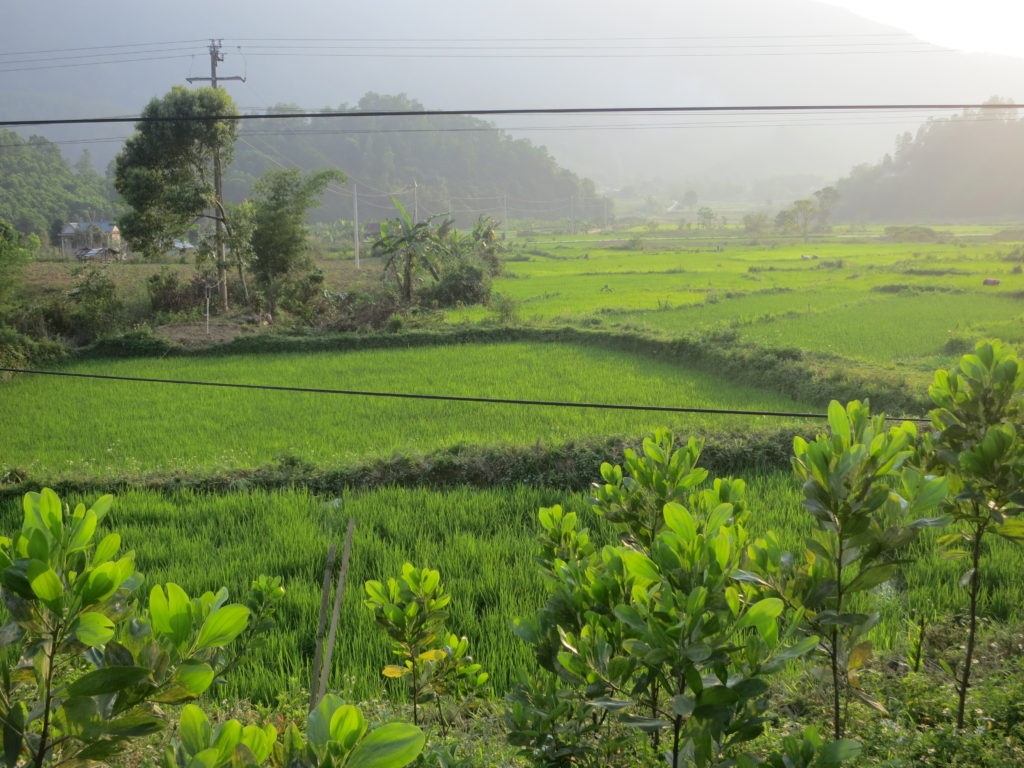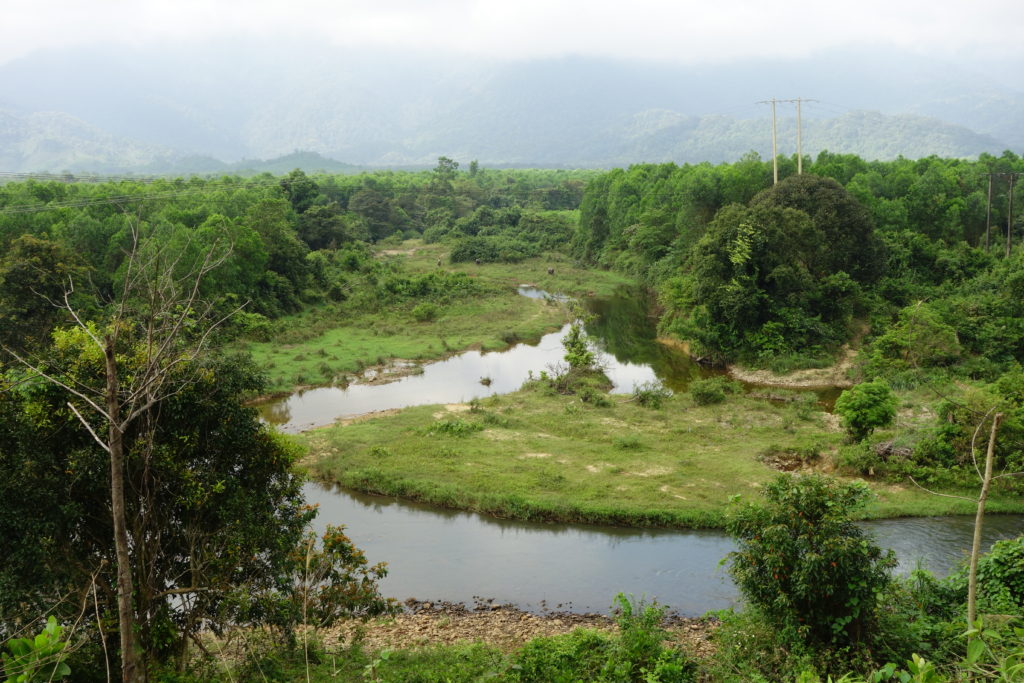Ashau Valley

Deep in to the cloud covered mountains bordering Laos the legendary Ashau Valley, where so many hard fought battles took place, sits. Places like Camp Ashau in the southern end of the valley, Hamburger Hill and Base area 611 are forever etched in to the memories of those who fought there. During the early years of the war, US troops established three special forces camps to cover the southern and center parts of the valley. Camp Ashau, Ta Bat and Aluoi Airfield. Where the site of Ta Bat is inundated large parts fo the year, Camp Ashau is a great visit and it is also possible to walk down the old runway at Aluoi Airfield.

Ashau Valley was one of the most important infiltration routes for the PAVN from the Ho Chi Minh trail in Laos. US and South Vietnamese troops, over the years, launched numerous combat operations in to the valley in order to try to prevent PAVN forces from infiltrating down towards the coastal areas of Da Nang and Hue. Reconnaissance troops climbed the hill sides, desperately trying to stay out of the way of enemy troops and at the same time gather as much information as possible.
The mountains sides were riddled with anti-aircraft installations in order to keep the US choppers and bombers out. Hillsides and tops were riddled with bunkers, fields hospitals and Together with the fact that at any given time Hanoi kept thousands of troops in the valley, this could have been one of the most fortified places in the country during the war.

Thanks to its unique geography and location, the Ashau valley was ideal for PAVN’s purposes staging and infiltration. This is also the reason US launched operations such as Delaware, Apache Snow and Dewey Canyon with the purposes of driving PAVN out of the valley and destroying its logistics and communications centers. In support of these operations US forces established numerous fireballs and radio relay stations. Most of those sites were located on the eastern ridge tops and are not really accessible today.
The valley stretches some 45 kilometers from south east to north west with the Laotian border just beyond the western ridges. The valley floor is around one and a half kilometer wide with the narrowest part being only a few hundred meters wide just north of Aluoi. While driving through the valley, seeing the craters from countless bombs that were dropped, imagining the airlifts coming in to the valley with hundreds of combat ready soldiers, tracers from anti aircraft guns painting the sky trying to take down the inbound choppers, it is impossible not to send a thought to the fighting men on both sides and the sacrifices they made.

Today the valley is a sleepy backwater with a few villages scattered across the valley and Aluoi which has grown in to a small town since its days as a US special forces camp. There are a couple of hotels in town for those who wants to stay the night. As much as the Ashau Valley is one of the most exciting and historically significant destinations in the country for the history traveler, it is also as beautiful as any landscape Vietnam has to offer. Having been the scene of some of the most violent battles during the last century, today the Ashau Valley’s serene beauty will make its visitors want to stay just a little longer.
JT
How to get there
Located in Thua Thien Province about 65 kilometers west of Hue along the Laotian border, the valley is easily reachable over day from Hue. For those traveling in north-south direction along the Ho Chi Minh Highway, the road stretches through the whole valley.
Back to I Corps>>>
Enjoyed reading your comments. I was with the 27th engineers A co. We built the road into the ashau valley. In sept. 69 I was the first g.i. to drive a 10 ton tractor into the valley. The road was so small that in the curves my trailer would slide over the side of the mountain and the tractor would be bouncing trying to pull it back on the road. A 3/4 ton truck with a guy from the stars and stripes was a long to document that trip. I left for the world within a week of that trip. Have looked for the article several times but no success in finding that edition. Anyway that was a crazy time we lived through
Sal
I was with the 2/506 in Feb 70 we lost 2 good man that and I got too
Richard S. Atkins says:
April 19, 2022 at 9:56 pm
Your comment is awaiting moderation. This is a preview; your comment will be visible after it has been approved.
I was on FSB Currahee on June 14-15 when we were attacked by a company of NVA sappers. We were hit three different times and locations throughout the night. we did catch them in the wire in front of the bunker line. I myself moved along and into the wire to retrieve weapons and make sure the enemy was dead. I rolled 2 over using wire encase they were booby trapped. as I moved along the wire I through grenades ahead of me in some places as they had taken cover in some depressions. At dawn I volunteered to do a body count with our major and one other man. we came under fire once but could not tell from where. as we progressed on the other side of a creek I spotted one enemy trying to escape and engaged him bringing him down. as we walked on I spotted an RPG sticking out from under the large roots of a tree over the bank of the creek. The major tried talking whoever was there to surrender. After no response though the RPG was pulled back under the roots. Fearing we would be fired at we opened fire first. It was found that 5 NVA were concealed there. We killed all 5. Total of 51 NVA were killed and 3 captured. I believe we had 4 wounded is all. I believe it was the only time a FSB was attacked by sappers and no US casualties were killed. I and the other soldier who’s name I cannot recall both received the silver star for our actions.
Was with the 1st Air Cav. We went into the valley in April of 68. Not fun many choppers shot down. This was just after we helped out the marines. That was not fun either. Lots of rats besides mortars and artillery coming in.
did you perhaps know a Kenny Delp . He was a gunner on a helicopter that was shot down on Apr. 25 in AShu Valley. He was my friend’s husband and they had only been married a few months. He arrived in Vietnam on April 5, 1968 and was killed on
April 28.
I to was with the 101 st. 1/327. 1968
Spent lots of time humping the mountains
It was so beautiful and so dangerous
I plan on going back when we can travel
Again I fell in love with the tropics and spent my working life living on Maui
Anyway. Left several hood friends in the valley. Mahalo gary Nixon
Roger, I was on firebase Rakkasan artillery with 211th battalion battery A in Oct of 1969. If possible I would like to get a copy of Stars and Stripes for October and November of 1969. Our 155 Howitzer was pictured on the cove of Stars and Stripes. I gave my copy to a friend and now wish I had kept it for my wife and kids.If anyone can guide me to a copy, I would really appreciate it. My email is: [email protected]. Thanks and thank you for your service.
Contact Stars and Stripes they may have a file photo.
I remember it well
Lost a lot of comrades on that hill. It was the toughest thing i have ever done. We were the best American soldiers that America had.
Rakkasan Forever
HHC BCO 3/187 101ST AIRBORNE 1969
Thank you for your comment Rodger. Are you going to the reunion this week?
Later this week I will publish a video from the visit to the hill and also a new article on this website. I’ll post a link here for you. I hope you will appreciate it.
Hi Brother. I was with the 2nd/506th until we were hit (in the Ashau) while waiting for the choppers on the LZ. That was on Friday, 13 Nov 1970. Thankfully, 50 years later, Friday 13 November 2020 went by without incident. Anyway, welcome back to the world Brother. Currahee!
Bill Yarbrough
[email protected]
I was on FSB Currahee on June 14-15 when we were attacked by a company of NVA sappers. We were hit three different times and locations throughout the night. we did catch them in the wire in front of the bunker line. I myself moved along and into the wire to retrieve weapons and make sure the enemy was dead. I rolled 2 over using wire encase they were booby trapped. as I moved along the wire I through grenades ahead of me in some places as they had taken cover in some depressions. At dawn I volunteered to do a body count with our major and one other man. we came under fire once but could not tell from where. as we progressed on the other side of a creek I spotted one enemy trying to escape and engaged him bringing him down. as we walked on I spotted an RPG sticking out from under the large roots of a tree over the bank of the creek. The major tried talking whoever was there to surrender. After no response though the RPG was pulled back under the roots. Fearing we would be fired at we opened fire first. It was found that 5 NVA were concealed there. We killed all 5. Total of 51 NVA were killed and 3 captured. I believe we had 4 wounded is all. I believe it was the only time a FSB was attacked by sappers and no US casualties were killed. I and the other soldier who’s name I cannot recall both received the silver star for our actions.
Richard, thank you for visiting our website and for sharing your story. I am happy you made it out of that battle and the war. It sounds like one well deserved Silver Star. Stories like yours, really helps in making history come alive as we understand more on what happened on the sites we visit. If you are on Facebook, we also have a group called Vietnam War History Travel. Our members are veterans, historians, history travelers and many other people who are interested in learning more about the history of the war. Many of us travel to and explore these historical sites to document them and share with the community. You are much welcome to join if you like.
/Jonas, founder of namwartravel